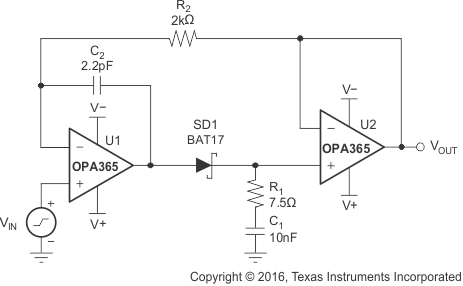SBOS365G may 2006 – may 2023 OPA2365 , OPA365
PRODUCTION DATA
- 1
- 1 Features
- 2 Applications
- 3 Description
- 4 Revision History
- 5 Device Comparison Table
- 6 Pin Configuration and Functions
- 7 Specifications
- 8 Detailed Description
- 9 Application and Implementation
- 10Device and Documentation Support
- 11Mechanical, Packaging, and Orderable Information
Package Options
Mechanical Data (Package|Pins)
- D|8
Thermal pad, mechanical data (Package|Pins)
Orderable Information
3 Description
The OPA365 and OPA2365 (OPAx365) zerø-crossover series, rail-to-rail, high-performance, CMOS operational amplifiers are optimized for very low voltage, single-supply applications. Rail-to-rail input or output, low-noise (4.5 nV/√Hz), and high-speed operation (50-MHz gain bandwidth) make these devices an excellent choice for driving sampling analog-to-digital converters (ADCs). Applications include audio, signal conditioning, and sensor amplification.
Special features include an excellent common-mode rejection ratio (CMRR), no input stage crossover distortion, high input impedance, and rail-to-rail input and output swing. The input common-mode range includes both the negative and positive supplies. The output voltage swing is within 10 mV of the rails.
The OPA365 (single version) is available in the micro-size SOT23-5 (SOT-5) and SOIC-8 packages. The OPA2365 (dual version) is offered in the SOIC-8 package. All versions are specified for operation from −40°C to +125°C. Single and dual versions have identical specifications for maximum design flexibility.
| PART NUMBER | CHANNEL COUNT | PACKAGE(1) |
|---|---|---|
| OPA365 | Single | D (SOIC, 8) |
| DBV (SOT-23, 5) | ||
| OPA2365 | Dual | D (SOIC, 8) |
 Fast-Settling Peak Detector
Fast-Settling Peak Detector